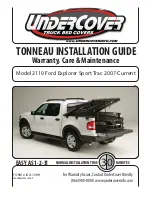
Chevrolet Silverado 4500HD/5500HD/6500HD Owner Manual (GMNA-
Localizing-U.S.-12102101) - 2019 - crc - 10/2/18
334
Vehicle Care
selection of air compressor
equipment, proper air line
routing, and the use of shop air
dryers is strongly recommended
to prevent moisture in the
high-pressure air used for tire
inflation.
Tire Inspection
{
Warning
To prevent property damage,
personal injury, and/or death,
always maintain your tires in
good condition. Frequently
check and maintain correct
inflation pressures as
specified by tire
manufacturers. Inspect
periodically for abnormal wear
patterns and repair/replace cut
or broken tire casing. Always
use experienced, trained
personnel with proper
(Continued)
Warning (Continued)
equipment and correct
procedures to mount or
remove tires and wheels.
Check the condition of the tires
for abnormal wear patterns and
proper inflation pressures. Cut
or broken tire casings must be
repaired or replaced.
Check the tread depth and tire
inflation. Check to see if the
tread is evenly worn. Minimum
tread depth is 3 mm (4/32 in) on
steering tires. Look for cuts or
other damage to the tread or
sidewalls. Check for missing,
broken, or damaged valve cap
and stem.
Check that the dual wheels,
if equipped, are evenly
separated, and that the tires are
not touching one another.
Tires should be inspected for the
following conditions. If any are
present, the tire should be
removed and repaired,
retreaded, or scrapped as the
condition indicates.
.
Any blister, bump, or raised
portion anywhere on the
surface of the tire tread or
sidewall (other than a bump
made by a repair). These
indicate the start of internal
separation.
.
Any cut that reaches to the
belt or ply cords or any cut
that is large enough to grow
in size and depth.
.
Any nail or puncturing object.
.
If any stone or object is held
by a tread groove and is
starting to drill into the tread
base, remove the object.
Proper tire inflation, toe-in
adjustment, loads, and road
speeds are important factors
















































